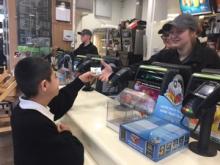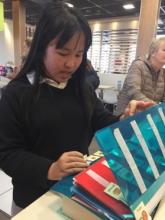
PECS (Picture Exchange Communication System):
Total Communication:
Communication is human interaction. For pupils with Autism all channels of communication support each other and it will always be easiest to speak if you are able to do so. We have found that invariably PECS improves speech as the pupil becomes more generally communicative and confident in their interactions.
The advantage of using pictures:
The spoken word vanishes in the air. It is there for a fraction of second and then is gone forever. Pictures last as long as a pupil needs to process their meaning and use them to communicate. In order to speak a pupil needs to have the word stored in their brain and retrieve that word and then articulate it. Pictures are offered as choices so the pupils does not have to retrieve a concept and its word (label) and articulate, they simply have to pick up and give to a "communication partner".
The importance of exchange:
The exchange element of PECS actively teaches pupils with ASC to find and use a “communication partner”. This develops awareness of other people and general communication skills. Whereas simply pointing at a picture requires a pupil to be aware of, and check for, joint attention with the person they wish to communicate with (check that the other person is looking at the same thing at the same time) the exchange of the picture ensures that the message is delivered in a physical way. It is therefore much more consistently successful and reinforces the pupil's attempts to communicate.
A clear structure of developing communication:
PECS works through a very clear and effect structure of communication that pupils can access to the maximum extent they are able. It starts simply with exchanging a 'ticket' as a way of requesting something, moves to using photos/symbols to request specific things along with the verbal "I want...." and then moves, when requesting is fully established, to commenting with "I see....." and "I hear...." Adjectives are then added systematically. By repeating this very simple and clear language it maximises language aquisition.
An accessible model of spoken language:
The exchange of a picture to request or comment on things not only offers efficient communication but, with staff modelling the verbal sentence each time, at once takes the pressure off the use of speech but therefore maximises the pupils’ chances of developing their own verbalisations (staff do not put pressure on pupils to verbalise as pressure is one of the main barriers to developing speech).


